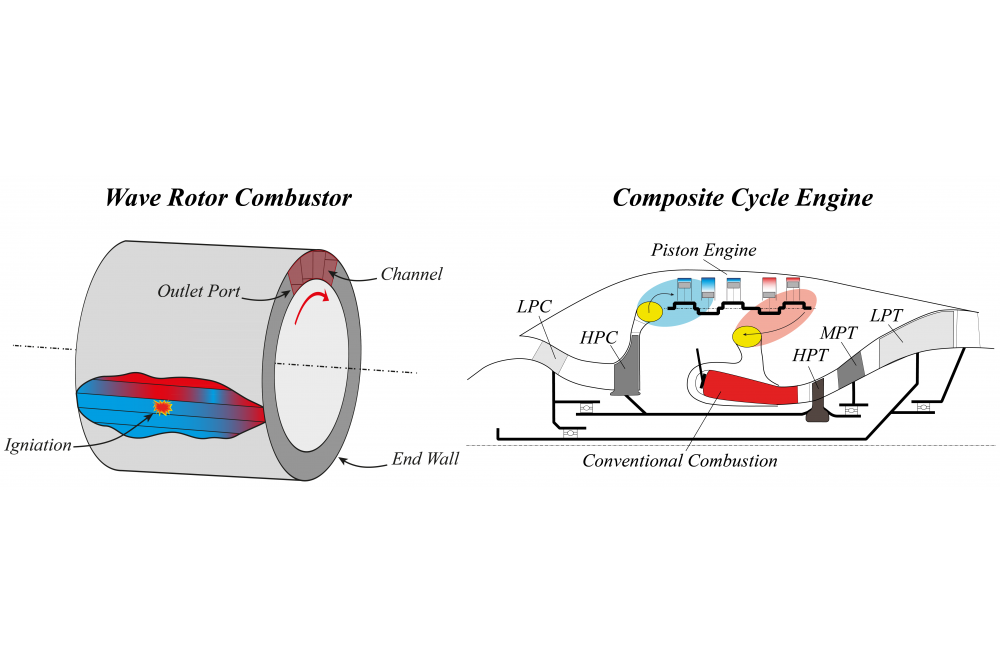TREVAP
Einleitung
TREVAP is the abreviation of "Technology for Revolutionary Working Processes" (Technologien für Revolutionäre Arbeitsprozesse).
The fact that efficiency of the currently used aircraft engine components is getting really close to its limits, and the achievement of aviation’s long term targets to reduce emissions cannot be attained by using traditional technologies. To obtain a higher efficiency class and therefore to reduce emissions, it is necessary to apply innovative and revolutionary technologies. The proposed technical solutions are based on cycle processes which are characterized by pressure gain combustion (PGC) methods. This type of combustion technology contributes to a significant thermal efficiency enhancement and low NOx-emission rates at the same time. The simplest form of PGC is an isochoric combustion. There are many different engine concepts (Composite Cycle Engine [1], Wave Rotor Combustor [2]) that is based on PCG. Compared with a conventional engine cycle, the new concepts offer an improvement in total efficiency and therefore an immense potential for fuel consumption.
Methoden
The development of such innovative engine concepts requires a holistic examination of their integrability. The combustion turbine interaction (CTI) is an important factor in this field. Novel combustor technologies affect the turbine design substantially. Studies on spatially inhomogeneous inflow have shown that the impact on the turbine efficiency and blade cooling is significant [3]. The CCE technology mainly impacts downstream in the form of transient inflow conditions, like periodic pressure fluctuations, that leads to a transient aerothermal load in the high pressure turbine (HPT). Previous studies have shown a negative impact of transient inflow conditions on turbine’s efficiency [4]. It is expected that this also applies to the cooling concepts in a conventional HPT. The task of the project was to quantify the underlying effects of transient inflow on the cooling mechanism in the HPT, such as film cooling. The numerical investigation of various test cases have shown that periodic pressure fluctuations, depending on magnitude and frequency, can significantly affect the film cooling characteristics.
Ergebnisse
It is assumed that the transient inflow will negatively affect the blade cooling in a conventional HPT. The scope of the project is to quantify the underlying effects of transient inflow on the cooling mechanism, such as film cooling. The numerical investigation of selected test cases, such as a flat plate with film cooling holes, has shown that the transient inflow leads to a reduction of film cooling effectiveness. This means, that the cooling flow is prevented from attaching to the plate surface. The changing vortices-structure in the vicinity of the film cooling holes, is the primary reason for less cooling. This insight is particularly significant because the sufficient cooling of the HPT plays an important role in the turbine design. To obtain a basic understanding, the numerical investigation was focussed on further test cases. Various geometries with different level of complexity were investigated in order to better isolate changing effects in the flow domain. The investigated test cases showed the same trend as the flat plate [5]. With the knowledge gained from the various test cases and further investigations on engine conditions, a realistic estimation should indicate to what extent conventional cooling concepts can satisfactorily perform in the case of highly unsteady inflow.
Ausblick
Due to the highly unsteady inflow and therefore unsteady mechanism within the flow domain, usual steady state simulations are not expedient. To receive accurate results, greater computing power is needed. Through the use of the high-performance computer, a fully transient simulation (URANS) with high temporally resolution and more complex turbulence models could be realized and thereby meaningful results received.





